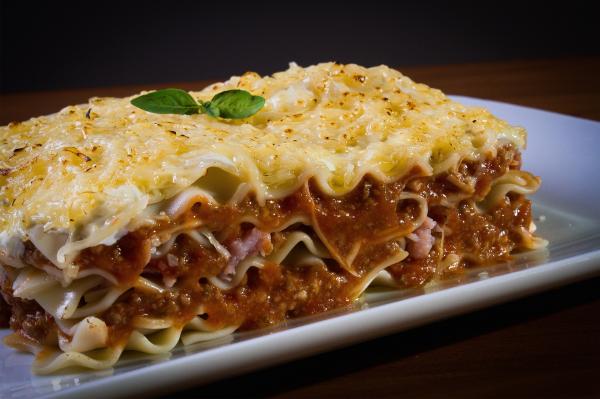Bob Wilson
So what does the New South Wales Covid lockdown mean for restaurants and cafes, some of which may have been planning for National Lasagne Day (29 July)?
Greater Sydney and surrounds and the whole of Victoria have been declared Covid red zones, with active cases multiplying rapidly.
A broad swathe of restrictions aimed at bringing the outbreak under control mean that in the NSW Red Zone areas’ thousands of pubs, clubs, restaurants and cafes are very much in a holding pattern. There’s no end in sight to the lockdown ending. So they will have their hands full paying the bills, never mind planning for a special foodie day.
If you had never heard of it, National Lasagne Day is a US celebration, a nod to the 5.5 million Italian migrants who found their way to the Big Apple and other American cities since the 1800s. Currently there are 2.2 million Italians living in the US, the majority in New York. So it is not difficult to find Italian restaurants or cafes, most of which are likely to have lasagne on the menu. And who hasn’t eaten the rich creamy dish with its layers of pasta sheets, interwoven with tomatoes, cheese, vegetables and meat sauce?
When we go out to eat, I am known for being unadventurous. If it’s not fish and chips it will be lasagne – ask anyone.
Which reminds me of the time in a Dublin pub when I decided I’d ordered haddock and chips one too many times.
“What does the lasagne come with?” I asked the waitress.
“Oh, the lasagne?” she said with a Dubliner’s lilt. “That’ll be coming with rice and chips and salad…but we haven’t got any.”
The website www.nationalday.com observes that lasagne first showed up in Naples, Italy during the Middle Ages. The dish made its way to America with the first Italian immigrants in the 19th century. An article in La Gazetta Italiano clears up a few myths about Italian food in the US. For example, only one third of food sold in the US as ‘Italian’ is imported from Italy.The remainder have Italian names, but are not the real deal.
My Dad (the baker) scoffed at Italian food such as pizzas. When the grandkids were planning to phone up and order pizzas he would claim (with a guttural Scots Och), that he could make a family sized pizza with meat toppings for about $2.
“What! $24 for a slice of bread in a cardboard box? Awa ye go.”
I might be recklessly paraphrasing the long-departed baker, but he is right to observe that Italian food is, in the main, highly profitable.
Of course, it depends on the reliability of suppliers, staff and other small business variables, not the least of which is rent. For even small shops in Sydney suburban high streets, rent is undoubtedly the single biggest expense.
So you have to feel sorry for bars, restaurants and cafes adversely affected by the current lockdowns in Greater Sydney and Victoria.
The one advantage is that Italian food is favoured by those who order takeaway foods. In 2019-2020, one pizza company alone (Dominos), sold 105.6m pizzas, through 833 stores in Australia and New Zealand.
As numerous articles in magazines such as Fortune have observed, the home delivered food business boomed during Covid in 2020. fortune.com/2020/08/12/coronavirus-food-trends-takeout-delivery-pizza-dominos-covid/
I was musing about this and that while waiting for our meals to arrive at the Yangan Hotel, a local watering hole outside Warwick.
We shared the dining room with two other groups at separate tables. No one wore masks and (gasp) I broke tradition and ordered rissoles.
Queensland has been handling the Covid cases it does have – about a tenth of what NSW is dealing with – in a responsible manner. So not surprisingly, we no longer have to wear masks when going out, although I notice some people still do. We are (still) in the lucky country part of the country with the Jumpers and Jazz festival pumping from the 15th to the 25th of July and all eateries open for sit-down catering.
In NSW, the lockdown rules are detailed and unambiguous for the food and drink hospitality industry; you can open, but only to sell takeaways or deliveries. But as Restaurant and Catering Association chief executive Wes Lambert told news.com.au, not all businesses can switch to takeaway and delivery service. He said small businesses were the most vulnerable to the lockdown, with some 93 per cent of food service industry businesses turning over less than $38,500 a week.
The Australian Retailers Association urged consumers to keep their essential shopping to a minimum. The ARA said in a press release that while retail stores were open, shoppers should take up digital options like click and collect.
“Every dollar you spend keeps someone in a job. It doesn’t matter if that purchase is made in a store or over the internet,” chief executive Paul Zhara said.
Back in Queensland, which, on 17 July, closed the border to all of Victoria and to the New South Wales hotspots, it’s business more or less as usual. The South-East coastal economies got an unexpected boost with the National Rugby League (NRL) deciding to move nine Sydney-based and three other regional teams to Queensland.
This decision will deliver a big pay day to the hand-picked accommodation outlets which become the teams’ bases for four weeks and maybe longer.
Hopefully players, staff and families will weigh in and support small business while they are here. Can you imagine South East Queensland’s Italian eateries and their couriers coping with 500-plus takeaway delivery orders for lasagne on July 29?
Importantly, National Lasagne Day is the day before we set off (with masks) to Suncorp Stadium for the Broncos’ clash with the Queensland Cowboys. So they’ll all have 24 hours to sleep off that big dose of carbohydrates (assuming it comes with rice, chips and salad).
Or they (the Broncos) could be like jockeys trying to make a lightweight ride and pick away at a green salad.
Yep, that’ll happen.
Bob’s weekly blog, Friday on My Mind is posted at www.bobwords.com.au.








